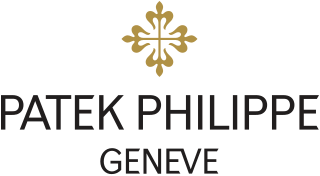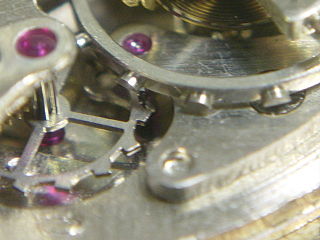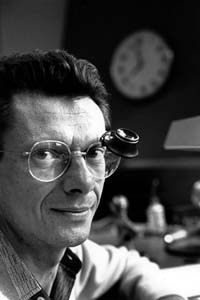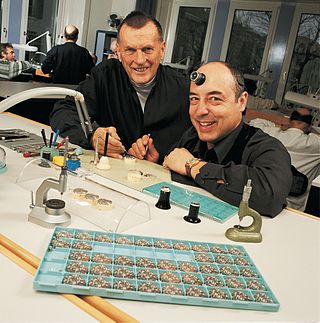
A watch is a portable timepiece intended to be carried or worn by a person. It is designed to keep a consistent movement despite the motions caused by the person's activities. A wristwatch is designed to be worn around the wrist, attached by a watch strap or other type of bracelet, including metal bands, leather straps, or any other kind of bracelet. A pocket watch is designed for a person to carry in a pocket, often attached to a chain.

Abraham-Louis Breguet, born in Neuchâtel, then a Prussian principality, was a horologist who made many innovations in the course of a career in watchmaking industry. He was the founder of the Breguet company, which is now the luxury watch division of the Swiss Swatch Group.

A watchmaker is an artisan who makes and repairs watches. Since a majority of watches are now factory-made, most modern watchmakers only repair watches. However, originally they were master craftsmen who built watches, including all their parts, by hand. Modern watchmakers, when required to repair older watches, for which replacement parts may not be available, must have fabrication skills, and can typically manufacture replacements for many of the parts found in a watch. The term clockmaker refers to an equivalent occupation specializing in clocks.

In horology, a movement, also known as a caliber or calibre, is the mechanism of a watch or timepiece, as opposed to the case, which encloses and protects the movement, and the face, which displays the time. The term originated with mechanical timepieces, whose clockwork movements are made of many moving parts. The movement of a digital watch is more commonly known as a module.

Patek Philippe SA is a Swiss luxury watch and clock manufacturer, located in the Canton of Geneva and the Vallée de Joux. Established in 1839, it is named after two of its founders, Antoni Patek and Adrien Philippe. Since 1932, the company has been owned by the Stern family in Switzerland and remains the last family-owned independent watch manufacturer in Geneva. Patek Philippe is one of the oldest watch manufacturers in the world with an uninterrupted watchmaking history since its founding. It designs and manufactures timepieces as well as movements, including some of the most complicated mechanical watches. The company maintains over 400 retail locations globally and over a dozen distribution centers across Asia, Europe, North America, and Oceania. In 2001, it opened the Patek Philippe Museum in Geneva.

In horology, a tourbillon is an addition to the mechanics of a watch escapement to increase accuracy. Conceived by the British watchmaker and inventor John Arnold, it was developed by his friend the Swiss-French watchmaker Abraham-Louis Breguet and patented by Breguet on 26 June 1801. In a tourbillon the escapement and balance wheel are mounted in a rotating cage, with the goal of eliminating errors of poise in the balance giving a uniform weight.

John Arnold was an English watchmaker and inventor.

A Roskopf, pin-lever, or pin-pallet escapement is an inexpensive, less accurate version of the lever escapement, used in mechanical alarm clocks, kitchen timers, mantel clocks and, until the 1970s, cheap watches now known as pin lever watches. It was popularized by German watchmaker Georges Frederic Roskopf in its "proletarian watch" from 1867. It was invented in 1798 by Louis Perron, of Besançon, and suggested to Roskopf by Jules Grossmann.

The Hamilton Watch Company is a Swiss manufacturer of wristwatches based in Bienne, Switzerland. Founded in 1892 as an American firm, the Hamilton Watch Company ended American manufacture in 1969. Through a series of mergers and acquisitions, the Hamilton Watch Company eventually became integrated into the Swatch Group, the world's largest watch manufacturing and marketing conglomerate.

Chronometry or Horology is the science of the measurement of time, or timekeeping. Chronometry provides a standard of measurement for time, and therefore serves as a significant reference for many and various fields of science.

The International Museum of Horology, French: Musée international d'horlogerie, is a horological museum in La Chaux-de-Fonds, Switzerland. It is owned and operated by the city of La Chaux-de-Fonds.

The National Watch and Clock Museum (NWCM), located in Columbia, Pennsylvania, is one of a very few museums in the United States dedicated solely to horology, which is the history, science and art of timekeeping and timekeepers.
Manufacture Jaeger-LeCoultre SA, or simply Jaeger-LeCoultre, is a Swiss luxury watch and clock manufacturer founded by Antoine LeCoultre in 1833 and is based in Le Sentier, Switzerland. Since 2000, the company has been a fully owned subsidiary of the Swiss luxury group Richemont.
The Watch Museum of Le Locle is a municipal museum specializing in horology, located in Le Locle, Canton of Neuchâtel, Switzerland. It is open to the public.

Gallet (ˈgæl.eɪ) is a historic Swiss manufacturer of high-end timepieces for professional, military, sports, racing, and aviation use. Gallet is the world's oldest clock making house with history dating back to Humbertus Gallet, a clock maker who became a citizen of Geneva in 1466. The Gallet & Cie name was officially registered by Julien Gallet (1806–1849) in 1826, who moved the family business from Geneva to La Chaux-de-Fonds, Switzerland. Prior to this date, operations commenced under the name of each of the Gallet family patriarchs.

Jean Lassale was a Swiss watch company that designed the Calibre 1200, featuring the thinnest mechanical watch movement: 1.2 mm. In the 1970s, Pierre Mathys, master watchmaker in La Chaux-de-Fonds, designed and built the prototype of a revolutionary watch caliber, with the goal of making the thinnest watch in the world. To achieve this feat, Mathys based his design on the work of Robert Annen, who previously had the idea of using ball bearings in small scale horology. Mathys decided to remove the bridges and counter-pivot, and instead use ball bearings for the axis.

Dominique Loiseau was a French and Swiss watchmaker who worked at the highest levels of complex horology from the mid 1970s onwards He was the creator of several notable timepieces, including six Montres de Sables, the Rose de Temps clock, the Renaissance or Capriccio pocket watches and the Blancpain 1735 wristwatch. In 2011 he presented, the Loiseau 1f4, one of the most complicated automatic watches with eight patents. Loiseau announced in 2012 a collaboration with Swiss watch manufacturer Girard-Perregaux.

Charles Oudin is one of the oldest French horology firms. It was founded in Paris at the end of the 18th century by Jean-Charles Oudin, who came from a family of clockmakers in Northwest France. There were four generations of Oudins who were clockmakers, as of the mid 18th century, first in the Meuse region and later, in Paris. Several members of the Oudin family worked for the master watch and clockmaker Abraham-Louis Breguet.

Ludwig Oechslin is a Swiss watchmaker, designer and inventor.

A Boule de Genève is a type of pendant watch in the shape of a small ball or sphere originating from Geneva, (Switzerland). The dial is usually at the bottom of the sphere facing the floor, at the opposite side of the jump ring on the upper part of the sphere, although there are examples with a front view face. Usually, they were arabic numeral dials, sometimes Roman, and from the 1950s different types of hour markers were also used. This objet de vertu frequently came with a matching brooch, chain or chatelaine.


















